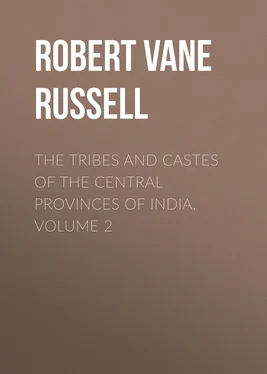Robert Vane Russell - The Tribes and Castes of the Central Provinces of India, Volume 2
Здесь есть возможность читать онлайн «Robert Vane Russell - The Tribes and Castes of the Central Provinces of India, Volume 2» — ознакомительный отрывок электронной книги совершенно бесплатно, а после прочтения отрывка купить полную версию. В некоторых случаях можно слушать аудио, скачать через торрент в формате fb2 и присутствует краткое содержание. Жанр: foreign_prose, История, foreign_edu, foreign_antique, на английском языке. Описание произведения, (предисловие) а так же отзывы посетителей доступны на портале библиотеки ЛибКат.
- Название:The Tribes and Castes of the Central Provinces of India, Volume 2
- Автор:
- Жанр:
- Год:неизвестен
- ISBN:нет данных
- Рейтинг книги:4 / 5. Голосов: 1
-
Избранное:Добавить в избранное
- Отзывы:
-
Ваша оценка:
- 80
- 1
- 2
- 3
- 4
- 5
The Tribes and Castes of the Central Provinces of India, Volume 2: краткое содержание, описание и аннотация
Предлагаем к чтению аннотацию, описание, краткое содержание или предисловие (зависит от того, что написал сам автор книги «The Tribes and Castes of the Central Provinces of India, Volume 2»). Если вы не нашли необходимую информацию о книге — напишите в комментариях, мы постараемся отыскать её.
The Tribes and Castes of the Central Provinces of India, Volume 2 — читать онлайн ознакомительный отрывок
Ниже представлен текст книги, разбитый по страницам. Система сохранения места последней прочитанной страницы, позволяет с удобством читать онлайн бесплатно книгу «The Tribes and Castes of the Central Provinces of India, Volume 2», без необходимости каждый раз заново искать на чём Вы остановились. Поставьте закладку, и сможете в любой момент перейти на страницу, на которой закончили чтение.
Интервал:
Закладка:
4. The Yādavas and Krishna.
It cannot necessarily be assumed that all the above traditions relate to the Abhīra tribe proper, of which the modern Ahīr caste are scarcely more than the nominal representatives. Nevertheless, it may fairly be concluded from them that the Abhīras were widely spread over India and dominated considerable tracts of country. They are held to have entered India about the same time as the Sakas, who settled in Gujarāt, among other places, and, as seen above, the earliest records of the Abhīras show them in Nāsik and Kāthiāwār, and afterwards widely spread in Khāndesh, that is, in the close neighbourhood of the Sakas. It has been suggested in the article on Rājpūt that the Yādava and other lunar clans of Rājpūts may be the representatives of the Sakas and other nomad tribes who invaded India shortly before and after the Christian era. The god Krishna is held to have been the leader of the Yādavas, and to have founded with them the sacred city of Dwārka in Gujarāt. The modern Ahīrs have a subdivision called Jāduvansi or Yāduvansi, that is, of the race of the Yādavas, and they hold that Krishna was of the Ahīr tribe. Since the Abhīras were also settled in Gujarāt it is possible that they may have been connected with the Yādavas, and that this may be the foundation for their claim that Krishna was of their tribe. The Dyashraya-Kavya of Hemachandra speaks of a Chordasama prince reigning near Junagarh as an Abhīra and a Yādava. But this is no doubt very conjectural, and the simple fact that Krishna was a herdsman would be a sufficient reason for the Ahīrs to claim connection with him. It is pointed out that the names of Abhīra chieftains given in the early inscriptions are derived from the god Siva, and this would not have been the case if they had at that epoch derived their origin from Krishna, an incarnation of Vishnu. “If the Abhīras had really been the descendants of the cowherds (Gopas) whose hero was Krishna, the name of the rival god Siva would never have formed components of the names of the Abhīras, whom we find mentioned in inscriptions. Hence the conclusion may safely be drawn that the Abhīras were by no means connected with Krishna and his cowherds even as late as about A.D. 300, to which date the first of the two inscriptions mentioned above is to be assigned. Precisely the same conclusion is pointed to by the contents of the Harivansha and Bhagwat Purāna. The upbringing of Krishna among the cowherds and his flirtations with the milkmaids are again and again mentioned in these works, but the word Abhīra does not occur even once in this connection. The only words we find used are Gopa, Gopi and Vraja. This is indeed remarkable. For the descriptions of the removal of Krishna as an infant to Nanda, the cowherd’s hut, of his childhood passed in playing with the cowherd boys, and of his youth spent in amorous sports with the milkmaids are set forth at great length, but the word Abhīra is not once met with. From this only one conclusion is possible, that is, that the Abhīras did not originally represent the Gopas of Krishna. The word Abhīra occurs for the first time in connection with the Krishna legend about A.D. 550, from which it follows that the Abhīras came to be identified with the Gopas shortly before that date.” 23 23 Bombay Ethnographic Survey.
This argument is interesting as showing that Abhīra was not originally an occupational term for a herdsman, nor a caste name, but belonged to an immigrant tribe. Owing apparently to the fact that the Abhīras, like the Gūjars, devoted themselves to a pastoral mode of life in India, whereas the previous Aryan immigrants had settled down to cultivation, they gave their name to the great occupational caste of herdsmen which was subsequently developed, and of which they may originally have constituted the nucleus. The Gūjars, who came to India at a later period, form a parallel case; although the Gūjar caste, which is derived from them, is far less important than the Ahīr, the Gūjars have also been the parents of several Rājpūt clans. The reason why the early Mathura legends of Krishna make no mention of the Ahīrs may be that the deity Krishna is probably compounded of at least two if not more distinct personalities. One is the hero chief of the Yādavas, who fought in the battle of the Pandavas and Kauravas, migrated to Gujarāt and was killed there. As he was chief of the Yādavas this Krishna must stand for the actual or mythical personality of some leader of the immigrant nomad tribes. The other Krishna, the boy cowherd, who grazed cattle and sported with the milkmaids of Brindāban, may very probably be some hero of the indigenous non-Aryan tribes, who, then as now, lived in the forests and were shepherds and herdsmen. His lowly birth from a labouring cowherd, and the fact that his name means black and he is represented in sculpture as being of a dark colour, lend support to this view. The cult of Krishna, Mr. Crooke points out, was comparatively late, and probably connected with the development of the worship of the cow after the decay of Buddhism. This latter Krishna, who is worshipped with his mother as a child-god, was especially attractive to women, both actual and prospective mothers. It is quite probable therefore that as his worship became very popular in Hindustān in connection with that of the cow, he was given a more illustrious origin by identification with the Yādava hero, whose first home was apparently in Gujarāt. In this connection it may also be noted that the episodes connected with Krishna in the Mahābhārata have been considered late interpolations.
5. The modern Ahīrs an occupational caste.
But though the Ahīr caste takes its name and is perhaps partly descended from the Abhīra tribe, there is no doubt that it is now and has been for centuries a purely occupational caste, largely recruited from the indigenous tribes. Thus in Bengal Colonel Dalton remarks that the features of the Mathurāvāsi Goālas are high, sharp and delicate, and they are of light-brown complexion. Those of the Magadha subcaste, on the other hand, are undefined and coarse. They are dark-complexioned, and have large hands and feet. “Seeing the latter standing in a group with some Singhbhūm Kols, there is no distinguishing one from the other. There has doubtless been much mixture of blood.” 24 24 Quoted in Tribes and Castes of Bengal , art. Goāla.
Similarly in the Central Provinces the Ahīrs are largely recruited from the Gonds and other tribes. In Chānda the Gowāris are admittedly descended from the unions of Gonds and Ahīrs, and one of their subcastes, the Gond-Gowāris, are often classed as Gonds. Again, the Kaonra Ahīrs of Mandla are descended from the unions of Ahīrs either with the Gonds or Kawars, and many of them are probably pure Gonds. They have Gond sept-names and eat pork. Members of one of their subdivisions, the Gond-Kaonra, will take water from Gonds, and rank below the other Kaonras, from whom they will accept food and water. As cattle have to go into the thick jungles to graze in the hot weather, the graziers attending them become intimate with the forest tribes who live there, and these latter are also often employed to graze the cattle, and are perhaps after a time admitted to the Ahīr caste. Many Ahīrs in Mandla are scarcely considered to be Hindus, living as they do in Gond villages in sole company with the Gonds.
6. Subcastes.
The principal subcastes of the Ahīrs in northern India are the Jāduvansi, Nāndvansi and Gowālvansi. The Jāduvansi claimed to be descended from the Yādavas, who now form the Yādu and Jādon-Bhatti clans of Rājpūts. The probability of a historical connection between the Abhīras and Yādavas has already been noticed. The Nāndvansi consider their first ancestor to have been Nānd, the cowherd, the foster-father of Krishna; while the name of the Gowālvansi is simply Goāla or Gauli, a milkman, a common synonym for the caste. The Kaonra Ahīrs of Mandla and the Kamarias of Jubbulpore are considered to belong to the Nāndvansi group. Other subcastes in the northern Districts are the Jijhotia, who, like the Jijhotia Brāhmans, take their name from Jajhoti, the classical term for Bundelkhand; the Bharotia; and the Narwaria from Narwar. The Rāwats of Chhattīsgarh are divided into the Jhadia, Kosaria and Kanaujia groups. Of these the Jhadia or ‘jungly,’ and Kosaria from Kosala, the ancient name of the Chhattīsgarh country, are the oldest settlers, while the Kanaujia are largely employed as personal servants in Chhattīsgarh, and all castes will take water from their hands. The superior class of them, however, refuse to clean household cooking vessels, and are hence known as Thethwār, or exact or pure, as distinguished from the other Rāwats, who will perform this somewhat derogatory work.
Читать дальшеИнтервал:
Закладка:
Похожие книги на «The Tribes and Castes of the Central Provinces of India, Volume 2»
Представляем Вашему вниманию похожие книги на «The Tribes and Castes of the Central Provinces of India, Volume 2» списком для выбора. Мы отобрали схожую по названию и смыслу литературу в надежде предоставить читателям больше вариантов отыскать новые, интересные, ещё непрочитанные произведения.
Обсуждение, отзывы о книге «The Tribes and Castes of the Central Provinces of India, Volume 2» и просто собственные мнения читателей. Оставьте ваши комментарии, напишите, что Вы думаете о произведении, его смысле или главных героях. Укажите что конкретно понравилось, а что нет, и почему Вы так считаете.












